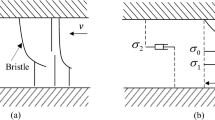Abstract
This paper proposes a novel idea that classifies faults into two different kinds: serious faults and small faults, and treats them with different strategies respectively. A kind of artificial neural network (ANN) is proposed for detecting serious faults, and variable structure (VS) model-following control is constructed for accommodating small faults. The proposed framework takes both advantages of qualitative way and quantitative way of fault detection and accommodation. Moreover, the uncertainty case is investigated and the VS controller is modified. Simulation results of a remotely piloted aircraft with control actuator failures illustrate the performance of the developed algorithm.
Similar content being viewed by others
References
J. J. Gertler. Fault Detection and Diagnosis in Engineering Systems[M]. New York: Marcel Dekker, 1998.
J. Chen, R. J. Patton. Robust Model-based Fault Diagnosis for Dynamics Systems[M]. Boston: Kluwer Academic Publishers, 1999.
D. Zhou, Y. Ye. Modern Diagnosis and Fault Tolerant Control[M]. Beijing: Tsinghua University Publishing House, 2000.
V. Venkatasubramanian, R. Rengaswamy, S. N. Kavuri. A review of process fault detection and diagnosis. I & II[J]. Computers and Chemical Engineering, 2003, 27(3): 293–326.
B. Jiang, J. Wang, Y. C. Soh. An adaptive technique for robust diagnosis of faults with independent effect on system output[J]. International Journal of Control, 2002, 75(11): 792–802.
B. Jiang, F. N. Chowdhury. Fault estimation and accommodation for linear MIMO discrete-time systems[J]. IEEE Transactions on Control System Technology, 2005, 13(3): 493–499.
W. Lee, C. Park. Fault diagnosis of an Air-Handling unit using artificial neural networks[J]. ASHRAE Transactions, 1996, 102(1): 540–549.
M. A. Demetriou, M. M. Polycarpou. Incipient fault diagnosis of dynamical systems using online approach[J]. IEEE Transactions on Automatic Control, 1998, 43(11): 1612–1617.
L. Hsu, R. Costa. Variable structure model reference adaptive control using only I/O measurements[J]. International Journal of Control, 1989, 49(2): 399–416.
K. S. Narendra, A. M.Annaswamy. Stable Adaptive Systems[M], Englewood Cliffs, New Jersey: Prentice-Hall, 1989.
H. Yang, B. Jiang, J. Wang. Disturbance rejection using neural network for reconfigurable flight control[C]// Proceedings of the 24th Chinese Control Conference. Guangzhou: Printing House of South China University of Technology, 2005: 1420–1424.
J. D. Bošković, S. Li, R. K. Mehra. Robust supervisory faulttolrant flight control system[C]// Proceedings of the American Control Conference. Piscataway, New Jersey: IEEE Press, 2001: 1815–1820.
J. D. Bošković, R. K. Mehra. Stable multiple model adaptive flight control for accommodation of a large class of control effector failures[C]//Proceedings of the American Control Conference. Piscataway, New Jersey: IEEE Press, 1999: 1920–1924.
B. Jiang, F. N. Chowdhury. Parameter fault detection and estimation of a class of nonlinear systems using observers[J]. Journal of the Franklin Institute, 2005, 342(7): 725–736.
P. A. Ioannou, J. Sun. Robust Adaptive Control[M]. Englewood Cliffs, New Jersey: Prentice Hall, 1995.
A. P. Oliva. Actuator and sensor failure effects on flying qualities[C]// Proceedings of the AIAA Guidance, Navigation, and Control Conference. Piscataway, New Jersey: IEEE Press, 2002: 279–284.
Author information
Authors and Affiliations
Additional information
This work was supported by National Natural Science Foundation of China (60574083), Key Laboratory of Process Industry Automation, Ministry of Education of China (PAL200514) and Innovation Scientific Fund of Nanjing University of Aeronautics and Astronautics (Y0508-031).
Hao YANG is a Ph.D. candidate of Nanjing University of Aeronautics and Astronautics (NUAA), China and Université des Sciences et Technologies de Lille, France. His research interests include fault diagnosis and fault tolerant control, adaptive control, neural network.
Bin JIANG is a Professor at the College of Automation Engineering, Nanjing University of Aeronautics and Astronautics. He received his Ph.D. degree in Automatic Control from Northeastern University, Shenyang, China, in 1995. He had been a postdoctoral fellow in Nanyang Technological University (Singapore), University of Science and Technology of Lille (France), National Center for Scientific Research (France) and University of Louisiana at Lafayette (USA), respectively. He is a senior member of IEEE and serves as associate editors for International Journal of System Science, International Journal of Control, Automation and Systems, International Journal of Innovative, Computing, Information and Control. His research interests include fault diagnosis and fault tolerant control, nonlinear system control, flight control and robot control.
Rights and permissions
About this article
Cite this article
Yang, H., Jiang, B. Fault detection and accommodation via neural network and variable structure control. J. Control Theory Appl. 5, 253–260 (2007). https://doi.org/10.1007/s11768-005-5204-7
Received:
Revised:
Issue Date:
DOI: https://doi.org/10.1007/s11768-005-5204-7




